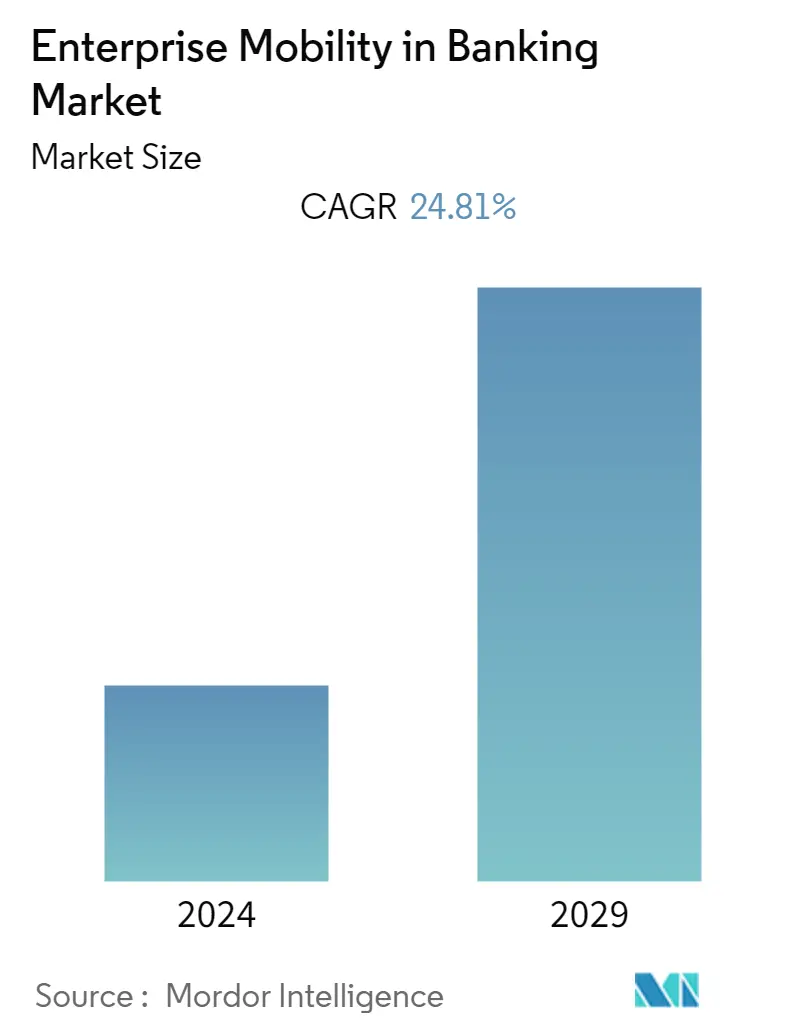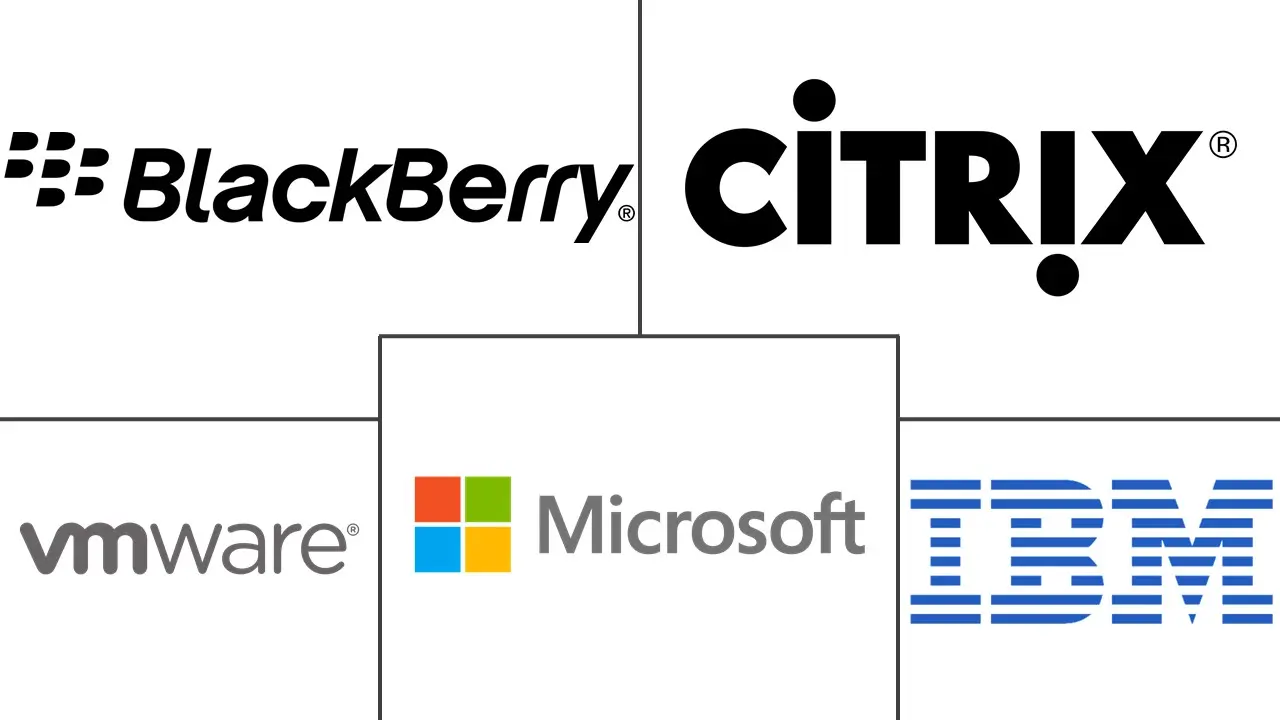Market Size of Enterprise Mobility in Banking Industry

| Study Period | 2019 - 2029 |
| Base Year For Estimation | 2023 |
| CAGR | 24.81 % |
| Fastest Growing Market | Asia Pacific |
| Largest Market | North America |
| Market Concentration | Low |
Major Players
*Disclaimer: Major Players sorted in no particular order |
Banking Enterprise Mobility Market Analysis
The Enterprise Mobility market in banking is expected to grow at a CAGR of 24.81% during the forecast period. Banks are more transaction-led than customer-centric, which inhibits them from fully engaging their customers, making it easier to personalize and streamline the mobile user experience. Thus, there is a need for enterprise mobility in the banking sector.
- Mobile devices are almost ubiquitous and are displaying similar trends across enterprises. Thus, deploying appropriate controls in companies is expected to benefit them from mobility opportunities while ensuring that sensitive data and devices are safeguarded. For instance, an EMM policy ensures that the enterprise's application, content, and device are fully integrated and safe to use, including secure access mechanisms.
- The banks and allies are pivoting to allow BYOD and require EMM for secure data and regulatory compliance for their financial exchanges. With the proliferation of multiple OS, like macOS, Windows 10, and ruggedized devices, along with the Internet of Things (IoT), the mobile hardware context enlarges, enabling enterprises to focus on EMM.
- Further, the banking industry needs a proper system to manage the overall inventory of devices and track whether the devices are online or offline. Banks primarily need to keep track of all their mobile devices used in the field by the salesforce and ensure that the employees are using them effectively. Any unintended use of the devices, such as watching non-related videos, playing games, or installing any app, can lead to a loss of productivity.
- Additionally, the coronavirus outbreak caused an unpredictable worldwide situation for most businesses. Banks needed to enable their employees to operate remotely in the banking industry immediately. The rising need for digital infrastructure to facilitate the continuation of uninterrupted services is expected to create a demand for mobility solutions in the industry.
- However, one of the critical challenges and barriers to entry for mobilization is the high cost. Even with BYOD solutions, the budget still has to cover integration, development, telecom, and many others. Also, integrating new mobile apps and technologies into the existing infrastructure can be expensive and time-consuming.
Banking Enterprise Mobility Industry Segmentation
Enterprise mobility comprises a set of tools and technologies to maintain and manage mobile or handheld devices used within an organization during routine business operations. The solutions exhaustively consider mobile device management, mobile access management, and mobile application management as part of our market analysis. Enterprise mobility has changed the way banks run businesses. Banks work in an aggressive commercial center with extending customer wants, so they have to reorient themselves and make use of mobility solutions to overcome challenges related to customer satisfaction.
The Enterprise Mobility in Banking market is segmented by Type ( Solutions ( Device Management, Access Management, Application Management, and Other Solutions) and Services) and Geography (North America, Europe, and Asia-Pacific).
The market sizes and forecasts are provided in terms of value (USD million) for all the above segments.
The market sizes and forecasts are provided in terms of value (USD million) for all the above segments.
| By Type | ||||||
| ||||||
| Services |
| Geography | |
| North America | |
| Europe | |
| Asia Pacific | |
| Rest of the World |
Enterprise Mobility in Banking Market Size Summary
The banking enterprise mobility market is poised for significant growth, driven by the increasing need for banks to enhance customer engagement and streamline mobile user experiences. As mobile devices become ubiquitous, banks are recognizing the importance of implementing enterprise mobility management (EMM) solutions to safeguard sensitive data and ensure regulatory compliance. The shift towards bring your own device (BYOD) policies and the integration of various operating systems and IoT devices are expanding the mobile hardware landscape, prompting banks to focus on effective mobility strategies. The COVID-19 pandemic further accelerated the demand for digital infrastructure, necessitating remote operations and uninterrupted service delivery, which in turn fueled the adoption of mobility solutions in the banking sector.
Despite the promising growth prospects, the banking enterprise mobility market faces challenges such as high costs associated with integration and development, as well as the need to secure IT systems against cyber threats. Data breaches pose significant risks, with financial institutions being prime targets for cyber attackers. As customer expectations and regulatory requirements rise, banks are compelled to adopt advanced security measures and leverage digital channels like mobile and internet banking. North America is expected to hold a substantial market share, driven by the increasing adoption of mobility solutions and the presence of major vendors. The market is characterized by fragmentation, with numerous players offering on-premise or cloud-based mobility solutions, focusing primarily on smartphone-related services.
Enterprise Mobility in Banking Market Size - Table of Contents
-
1. MARKET SEGMENTATION
-
1.1 By Type
-
1.1.1 Solutions
-
1.1.1.1 Device Management
-
1.1.1.2 Access Management
-
1.1.1.3 Application Management
-
1.1.1.4 Other Solutions
-
-
1.1.2 Services
-
-
1.2 Geography
-
1.2.1 North America
-
1.2.2 Europe
-
1.2.3 Asia Pacific
-
1.2.4 Rest of the World
-
-
Enterprise Mobility in Banking Market Size FAQs
What is the current Enterprise Mobility in Banking Market size?
The Enterprise Mobility in Banking Market is projected to register a CAGR of 24.81% during the forecast period (2024-2029)
Who are the key players in Enterprise Mobility in Banking Market?
BlackBerry Limited, VMware Inc., Citrix Systems Inc., IBM Corporation and Microsoft Corporation are the major companies operating in the Enterprise Mobility in Banking Market.

